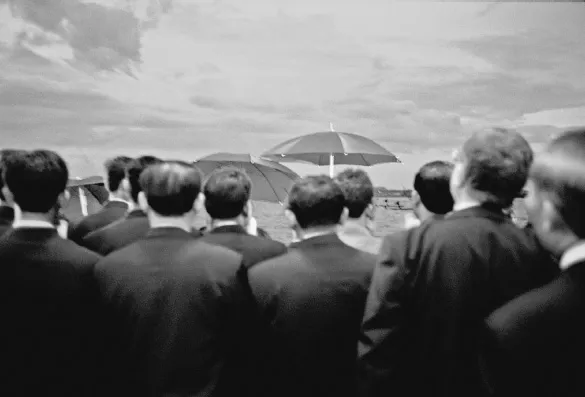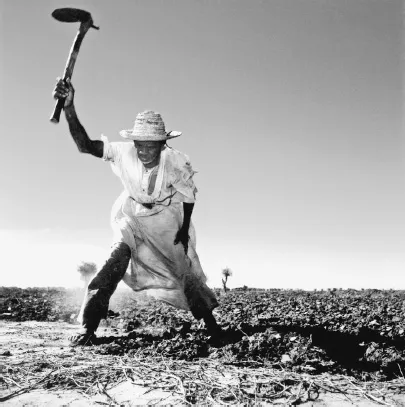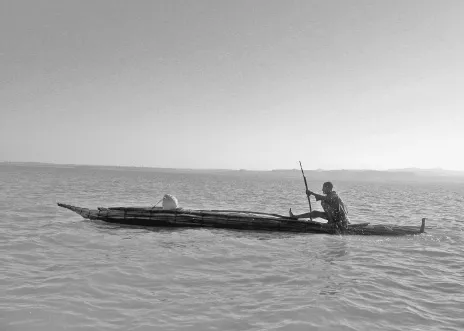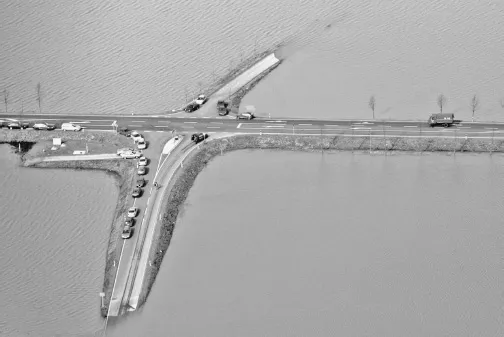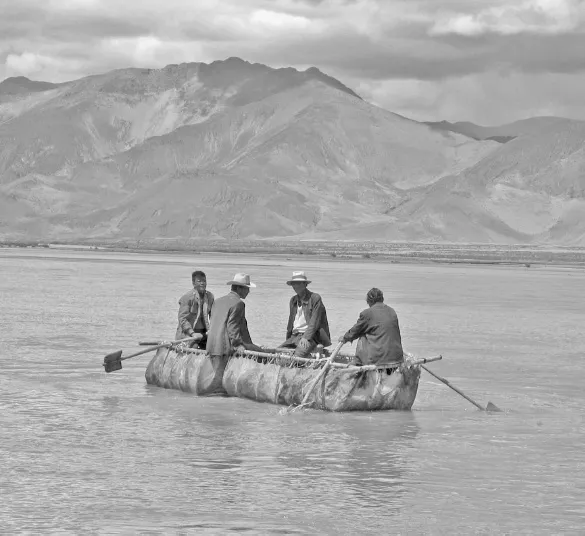![]()
PART 1
THE NEW UNCERTAINTY ABOUT WATER
![]()
4. We are now living in the new Age of Uncertainty. Everywhere people are wondering how they can secure themselves a future that no one can know with certainty: will there be more precipitation or less, more floods and more droughts, greater melting of ice and higher sea levels?
INTRODUCTION TO PART I
In the mid-1990s, when I went travelling to almost 30 countries in connection with research and a television series I was making on the role of water in history, virtually nobody talked of global warming and changing water landscapes. Now, people everywhere are interpreting unusual weather as profound expressions of threatening climatic change. Nearly 3,000 metres above sea level among mud huts in Lesotho I encounter an old woman who wants to talk about the recent bad weather and who explains it as ‘global warming.’ At a reception in a beach hotel in Cancun, Yucatán, a Mexican Elvis impersonator complains that the weather is different now from what it was, due too so much CO2 in the atmosphere. And along the battered riverbank of the Bagmati in Nepal, an old engineer with large sad eyes and the firm conviction that the extremely modest volume of water in the river this year is due to global warming, has decided to devote the last years of his life to saving the country’s most sacred river from death by local pollution. Everywhere I go, I meet people sharing the same view; a new insecurity about precipitation, drought, glaciers and sea level is woven into the world’s collective consciousness.
In the course of a few short years the language of climate science has come to predominate in the grand narratives about the future of the planet and human responsibility for it. Hardly at any time in history have so many, so quickly, changed their ideas about such fundamental questions and to such a great extent. Since climate change in societies will first and foremost manifest itself in terms of the way that water flows in the landscape, the grand and mighty narratives about the future of humanity have suddenly become stories that rest on definitions and conceptualisations about how water will flow in that future.4
Given this background one can say that humanity has entered the age of uncertainty.
The new era will be shaped fundamentally by the permanent and growing insecurity regarding the water landscapes of the future. The media speculate and politicians and scientists discuss: are we standing at the beginning of centuries of drought and will a third of the planet become desert in 100 years time? Or are we living in the century of floods – of the melting of the ice? Will the world’s oceans rise by several metres and, if so, when will it actually happen? Predictions of such disasters involving water strike a deep chord in the human psyche.
5. Homo sapiens has developed into the world’s dominant species over the course of the last 10,000 years. Viewed from the perspective of long geological time spans this has been a period wherein the climate and the hydrological cycles have been unusually stable, providing our species with a relative paradise compared with earlier climatic periods.
In the course of my travels I have been re-reading the famous ancient flood myths: the 5,000-year-old epic of Gilgamesh from the lands between the Tigris and the Euphrates; the story of Noah’s Ark in the Bible; the final destruction of the world by flood in Buddhism; and some of the innumerable stories of disastrous floods that are to be found in different shades and variations in almost all religions and many grand cultural narratives. I have tried to hunt down depictions of the Great Flood by painters, and not only the well-known drawings and paintings by Michelangelo and Leonardo da Vinci. My favourite is Gustave Doré’s painting from 1865 having the very mundane yet precise title: World Destroyed by Water. It is full of contradictions: characterised by existential darkness yet at the same time it shows how the catastrophe releases the best side of human nature. People are portrayed desperately trying to flee from the rising seas. A father is attempting to keep his wife and children above the water. Above him, two parents are trying to push their children up on to dry land. In the middle of the picture we see the arm of a drowning parent trying to give their child a few more moments of life. And the sinners sacrifice themselves to save the innocent.5 These Doomsday portrayals are both appealing and appalling, yet they appear anachronistic because they lack what modern Doomsday prophets rely upon – the status of modern science. Thus, water now fights back, not as a boomerang, but as the familiar, returning in completely unfamiliar ways.
6. The more developed and complex a society is, the greater the costs society will have to bear and, indeed, the greater the challenges that have to be tackled in order to adapt to a changed waterscape. This is Lake Tana, Ethiopia, a lake that has lain undisturbed for thousands of years, but no longer.
In the very long term what is certain is that there will be great changes in local and regional water cycles. In the land of the Dogon people in Mali, on the edge of the Sahara, people have survived for generations with both little water and huge variations in precipitation. Here, what is constant in the water cycle is its inconstancy; what is normal is the certainty of the abnormal – that catastrophes will occur and that they will batter society. Lakes appear and disappear annually in this region, and as such they are natural barometers of the absolutely unique and eternal fickleness of the climate and the waterscape.
7. Ideas of flood and catastrophic flood damage are central to most religions. Thus we find that Doomsday prophecies have deep cultural traditions to draw upon and they are constantly reactivated, influenced by great floods like this one in Germany.
Once a year, the small Antogo lake is the scene of an extraordinary event: people come from far and wide to go fishing. The traditional belief is that the fish come from the neighbouring mountains. When the annual rains come, the water rises. The fish wash out of hidden lakes in the mountains, down the mountainsides and into the lake. On the great day, thousands of people gather around the little body of water. They sit in silence on the banks encircling the lake, waiting for the signal that is given when the water level is optimal for catching fish with their hands. At that point, they storm out into the water in their thousands. In the course of a few minutes the lake is emptied of fish. The people wade back, climb the banks, and in a little while the lake is no more.
From the perspective of climatic history this ritual fishery symbolises human impotence in the face of the power of the changing cycle of water. If the conditions of the last millennium have constituted a blissful climatic paradise, then, fundamentally, humanity finds itself in the same situation as the fishers at Lake Antogo when the water conditions are ideal. We have, of course, no reason to believe that the water conditions of the present will last. The extraordinary event at Lake Antogo is a fertility ritual that also underlines another paradox of history: the relative autonomy of poor village people in the face of the power of nature and water. Even though the lake disappears, the existence of the society is not threatened. People simply do something else, or migrate with their scant belongings to some other place. Modern society, with its huge cities of millions of people cramped together in very small areas, does not have the same options.
8. In China, 37,000 people are employed to influence the climate to a small extent. They shoot chemicals into the clouds in the hope of controlling local precipitation. This is done both to increase rainfall and, on occasion, to drive the clouds away whenever the government deems this appropriate. But what will be the long-term societal consequences if, demanding better weather, people go to the ballot box to choose a new government?
![]()
9. Tibetans rowing across the Brahmaputra in a yak-skin boat, surrounded by dry river banks and sandy deserts that remind one of the Sahara.
CHAPTER 1
TO THE RIVERS OF HEAVEN AND THE CENTRE OF THE WORLD
‘There is no doubt,’ he says, with an unflinching, rather sombre glance, ‘Many of the glaciers in Tibet will certainly melt.’
I am sitting with Yao Tang Dong, one of China’s leading glaciologists, in his office, a little outside the centre of Beijing. His friendly appearance adds to the drama of his research findings. He is certainly aware, I think to myself as I look through some of the reports he shows me, that his analyses will indirectly affect the future of 3 billion people and contribute to making remote Tibet into one of the most centrally strategic regions on earth.
When, six months later, I travel to Tibet I do so in the way that seems most appropriate for one who is interested in the country’s strategic significance for the future of the planet. I do not go by air, which distorts topographical proportions and earth-bound perceptions, such as descending to the alpine plateau; rather, I will climb up to it. I have therefore chosen to take the train to Tibet from Beijing.
On the first day, we pass through the landscape of the Yellow River, which is both the mother of joy and the mother of sorrow to the people of China. Unlike most rivers, the Yellow River is in fact completely brown and in some stretches contains seven parts muddy ooze to three parts water. I gaze upon what, over thousands of years, has been not only the begetter of a civilisation, but also a violent, terrifying river, the cause of more mass deaths than any other force in the history of the world. In 1887 alone it killed between 900,000 and 2 million people, and in 1931, between 1 million and 3.7 million. China’s history has revolved around this river and its control. It is the river that laid the basis for where the imperial kingdom of China was born: Xian; and where some years ago the mass grave of thousands of terracotta warriors, each formed with individual features was discovered. Here the river curls its way between an infinity of hilltops that more than anything else resemble earthenware pots with striated surfaces – but which are in fact laboriously constructed terraces that bear witness to the indomitable, millennia-old struggle of the Chinese against the very nature of water. Their aim has been to hold on to the fertile soil, such that even more of it will not wash into the river and increase the danger of flooding on the plains downstream toward the China Sea.
Map 1. If the ice of the Himalayas and other high-altitude plains melts, this will have a radical effect on the flow of water to the major rivers of Asia – the Yangtze, Yellow, Indus, Ganges, Brahmaputra, Salween, Amu Darya and Mekong rivers – which have shaped Asia’s history for thousands of years, and which will have increasing importance in the future.
The train reaches the alpine plateau on the second day and it becomes immediately evident that I have come to the water tower of Asia. I sit for hour after hour in the restaurant car of the train, dumbfounded, indeed bewitched, by a landscape that I have never seen anywhere else – barren rolling hills with flowing water almost covering the whole horizon, as though the rivers flow directly down from heaven. In the distance can be seen parts of the great Kunlun mountain chain that forms the physical and historical division between the Yellow and Yangtze River basins, or between southern and northern China. In China’s mythology this was the Taoist paradise, for it was here that King Mu, according to the legend, discovered the Jade Palace of Huang Di, the mythic Golden Emperor, creator of Chinese culture. We pass Tanggula Station – at 5,072 metres above sea level it is the world’s highest railway station – which has a building that seems to stretch up toward heaven as though in competition with the mountains in the distance.
10. This is the Yangtze, more than 4,000 metres above sea level, one of the many rivers that run through the rather sparsely populated Quinghai–Tibet plateau, before heading downstream.
The dining car steward interrupts me:
‘You sit here all day?’
Naturally enough, he wants to free up my table for subsequent business.
‘Yes,’ I say, ‘Absolutely, the whole day.’
I make the arrangements for a new order of noodles in order to keep my place at the panoramic viewing window. I try to identify the rivers from the map that I have spread out on the dining table between the chopsticks and the rice bowl, and follow their course, as lines of blue, down the Asian continent. The names are bewildering: like most other large rivers, the Yangtze has different names; here it is called Tuotuo and Tongtian (‘the river that passes into heaven’), while the Tibetan name is Drichu, or ‘the river of the female yak’.
‘How much cultural hubris and theoretical narrow-mindedness is there in intellectual traditions which maintain that the development of society and modernity have made the power of geography irrelevant?’ I wonder. I have a strong desire to shout this out for the whole dining car to hear, but there are only a few non-English-speaking Chinese sitting here, enveloped in clouds of cigarette smoke.6
The Tibetan Plateau is the source of the great river systems that gave birth to civilisations: not only the Yangtze and the Yellow rivers, but also the Indus, the Ganges, the Brahmaputra, the Salween, the Mekong rivers that over thousands of years have helped shape the history of Asia, and which in the future will have an increased significance economically, politically and culturally in China, India, Pakistan, Vietnam, Cambodia, Laos, Thailand, Nepal, Bangladesh, Burma and Bhutan. This region holds the key to the future of large parts of Asia. To an ever-increasing degree, Tibet will become one of the most strategically important areas on the globe. And this will be so whatever happens with the climate.
The landscape makes a profound impression – the crystal clear air, the blue ice-crested mountains in the distance, the cold light-green colour of the lakes, and the rivers with their innumerable tributaries, both large and small, flowing down the distant barren hills. Forty or 50 million years ago the Indian subcontinent collided with the rest of the landmass of Asia and the mountaintops then rose toward the heavens. In the twentieth century the area was popularised in exotic travel accounts as the land of ‘eternal ice and snow.’ This ice constitutes Asia’s water bank – 15,000 glaciers that collectively cover an area of more than 30 million square kilometres in the Himalayas. Questions about the future of these glaciers will to an ever-increasing degree concern all humanity, not only this year and next year, but thousand years from now.
As the sun makes its way across the sky, I leaf through the notes I made of my discussion with Yao the previous year, as well as interviews he has given and articles he has written.7 These reinforce his message: the glaciers recede every year, producing an amount of meltwater approximately equal to the annual water flow of the Yellow River. Many of the glaciers will soon be gone, as soon as 2035 it is argued, and they will all completely disappear by 2100! The temperature has increased, it is claimed, by one degree since 1950.
It has been said that only historians are mightier than God because they are in a position to change the past. The predictions of Yao and his colleagues – and they are only predictions, even should they happen to come true – imply that the researchers possess a defining power with regard to future development and will have a vital influence over how societies of billions of people will tackle the new future. What they find out and, not least, how they interpret their data and which scenarios they suggest, will have dramatic but completely unforeseeable consequences – and this will be so, irrespective of whether they prove to be right or wrong. When Yao says that 54 per cent of China’s glaciers will be history by 2050 if current trends continue, he is thus warning of an envir...

